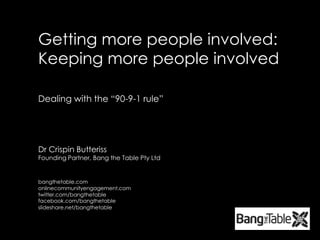Getting More People Involved: Keeping More People Involved
- 1. Getting more people involved: Keeping more people involvedDealing with the “90-9-1 rule”Dr Crispin ButterissFounding Partner, Bang the Table Pty Ltdbangthetable.comonlinecommunityengagement.com twitter.com/bangthetablefacebook.com/bangthetableslideshare.net/bangthetable
- 2. WHAT AM I TALKING ABOUT?Me & Bang the Table90-9-1 RuleOur dataThree case studiesTen principles for removing barriers to entry
- 3. Over 180 forums for over 70 clients in a little over 2 years
- 4. 90-9-1 RULEStates that... 90% of visitors are voyeurs9% of visitors get a little involved1% of visitors do most of the workMost people don’t have a lot to say
- 5. MORE A “GUIDING PRINCIPLE” THAN A LAW...10% of Twitter users make 90% of Tweets10% of Social Network users provide 30% of content15% of Wikipedia editors make 90% of edits5% of all Internet users blog“Inequality” is universal...and not limited to the web (just more measurable)
- 6. IS IT A PROBLEM? “Obviously, if you want to assess the "feelings of the community" it's highly unfair if one subgroup's [smaller group of] members have the same representation as another subgroup's [larger group of] members. More importantly, such inequities would give you a biased understanding of the community, because many differences almost certainly exist between people who post a lot and those who post a little. And you would never hear from the silent majority of lurkers.”Name withheld
- 7. IS THIS PROBLEM?“Obviously, if you want to assess the "feelings of the community" it's highly unfair if one subgroup's [smaller group] members have the same representation as another subgroup's 580,000 members. More importantly, such inequities would give you a biased understanding of the community, because many differences almost certainly exist between people who post a lot and those who post a little. And you would never hear from the silent majority of lurkers. “It isn’t obvious to me
- 8. LET’S TAKE ANOTHER LOOK“Obviously, if you want to assess the "feelings of the community" it's highly unfair if one subgroup's [smaller group] members have the same representation as another subgroup's [larger group] members. More importantly, such inequities would give you a biased understanding of the community, because many differences almost certainly exist between people who post a lot and those who post a little. And you would never hear from the silent majority of lurkers.”
- 9. IS PARTICIPATION INEQUALITY UNFAIR?No.As long as there are no deliberate or inadvertent barriers to entry.
- 10. DOES PARTICIPATION INEQUALITY CREATE A BIASED UNDERSTANDING?No.Policy is (or should be) created based on the strength of an argument, not the number of times it is repeated.
- 11. BUT WHAT ABOUT THE SILENT MAJORITY?Not a problem.Experience shows us that people will get involved if they feel strongly enough and that the web opens up the conversation to marginalised majorities.As long as there are no deliberate or inadvertent barriers to entry.
- 12. Participation inequality is only a problem if barriers prevent people from participating....Otherwise it is simply free will
- 13. Maybe they’re just not that into you!
- 14. More on removing barriers to entry later
- 16. Preferred?
- 19. THE LESSON...A few people have a lot to sayMore people have a little to sayMost people have nothing to say
- 20. And that’s okay. I’ll get to why in a moment.
- 21. CASE STUDIESThe Bays PrecinctAustralian Cultural PolicyPort Macquarie Hastings Council
- 26. TEN STEPS (+2) TO REMOVING BARRIERS TO ENTRY
- 27. 1CONSULTATION PROMOTIONGet the message to your target audience
- 28. 2CONSULTATION ACCESSIBILITYMake sure your consultation is available to folk with no web access
- 29. 3WEBSITE ACCESSIBILITYMake sure your website meets WCAG requirements
- 30. 4WEBSITEUSEABILITYMake sure your website is easy to navigate for newcomers
- 31. 5WEBSITEFUNCTIONALITYMake sure your website includes notifications systems to drive return traffic
- 32. 6FORUMFUNCTIONALITYGive the forum a clear structure and include “agree” and “disagree” with comment functions
- 33. 7WEBSITEAESTHETICSMake sure your website appeals to your target audience
- 34. 8KEY MESSAGESThis is copy writing, not report writing. Leave the jargon, technical detail and legalese in the background
- 35. 9FORUMQUESTIONSMake sure your questions resonate with your target audience. Are they concrete and visceral?
- 36. 10MODERATION & FACILITATIONKnow the difference.Moderation stops people getting upset; facilitation gets people more involved.
- 37. And just two more things...
- 38. 11CLARIFYOBJECTIVESAre your after traffic, comments, dialogue, agreement...?
- 39. 12REPORTINGCapture BOTH qualitative and quantitative data
- 40. THAT’S ITThanks for listening & questionsbangthetable.comonlinecommunityengagement.comfacebook.com/bangthetableTwitter.com/bangthetableşÝşÝߣshare.net/bangthetable





![IS IT A PROBLEM? “Obviously, if you want to assess the "feelings of the community" it's highly unfair if one subgroup's [smaller group of] members have the same representation as another subgroup's [larger group of] members. More importantly, such inequities would give you a biased understanding of the community, because many differences almost certainly exist between people who post a lot and those who post a little. And you would never hear from the silent majority of lurkers.”Name withheld](https://image.slidesharecdn.com/slideshareversionofedmontonpresentation-100127123656-phpapp01/85/Getting-More-People-Involved-Keeping-More-People-Involved-6-320.jpg)
![IS THIS PROBLEM?“Obviously, if you want to assess the "feelings of the community" it's highly unfair if one subgroup's [smaller group] members have the same representation as another subgroup's 580,000 members. More importantly, such inequities would give you a biased understanding of the community, because many differences almost certainly exist between people who post a lot and those who post a little. And you would never hear from the silent majority of lurkers. “It isn’t obvious to me](https://image.slidesharecdn.com/slideshareversionofedmontonpresentation-100127123656-phpapp01/85/Getting-More-People-Involved-Keeping-More-People-Involved-7-320.jpg)
![LET’S TAKE ANOTHER LOOK“Obviously, if you want to assess the "feelings of the community" it's highly unfair if one subgroup's [smaller group] members have the same representation as another subgroup's [larger group] members. More importantly, such inequities would give you a biased understanding of the community, because many differences almost certainly exist between people who post a lot and those who post a little. And you would never hear from the silent majority of lurkers.”](https://image.slidesharecdn.com/slideshareversionofedmontonpresentation-100127123656-phpapp01/85/Getting-More-People-Involved-Keeping-More-People-Involved-8-320.jpg)































